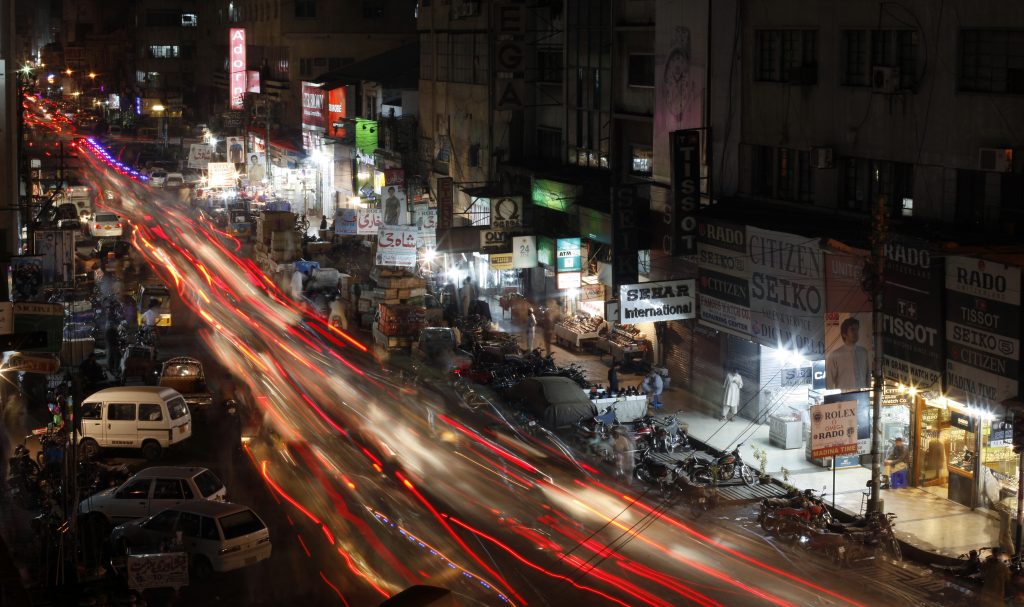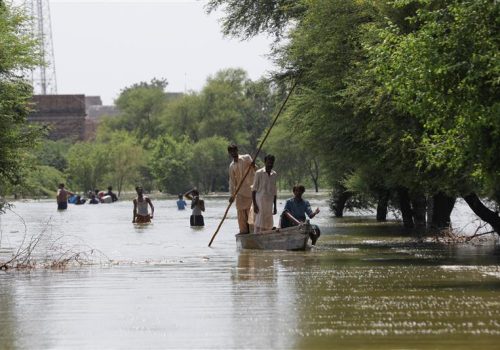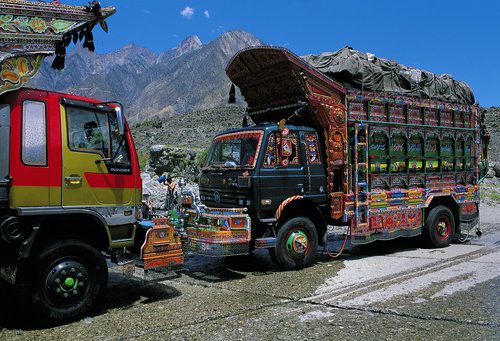Last week, Ishaq Dar returned to Pakistan for the first time since absconding from an accountability case five years ago.
It remains to be seen whether Pakistan’s justice system will find the wherewithal to adjudicate his case on merit alone. That said, Dar took his oath last Wednesday as finance minister, stepping into the role that Miftah Ismail had vacated a day earlier.
Pakistan has experienced 27 percent inflation this year, the consequence of the country’s persistent refusal to deal with its fiscal or trade deficits, and made worse by extreme fiscal imprudence and political instability. Dar’s first pronouncements as finance minister declared the Pakistani rupee undervalued. He vowed to reduce interest rates, fight inflation, and strengthen the exchange rate—the weakness of which he attributed to speculation.
If these early signals—consistent with his interviews over many months—are anything to go by, Dar and the country’s leadership learned nothing from his last stint as finance minister.
He had been fortunate then to preside over the country’s finances at a time of favorable external conditions: crude oil was especially cheap in the international market between 2014 and 2017, priced at less than half the rates witnessed earlier this year. These lower prices combined with a lower debt burden meant that Dar was able to loosen the government’s purse strings to catalyze growth and lower inflation in the short term. This move was widely panned by economists at the time, who warned about the vulnerabilities that Dar’s unsustainable policies were creating.
Instead of undertaking the long overdue project of serious tax reform, Dar had levied new withholding taxes and customs duties, increased the general sales tax, and over-relied on borrowing to allow the then-ruling Pakistan Muslim League, Nawaz (PML-N) to finance projects of questionable value, such as a large and underused Islamabad Airport that cost about $1 billion.
He had also been responsible for the Finance Ministry at a time when Pakistan was committing to huge new loans to finance the China-Pakistan Economic Corridor (CPEC). History has shown such financial planning to have been very poor. The PML-N government’s chief economist claimed in 2017, for example, that 4 percent of global trade would pass through the Corridor by 2020, with rental fees of $6-8 billion per year paying for CPEC costs.
Unfortunately, Pakistan’s failure to prudently manage those liabilities has caused distress to its Chinese partners and stalled work on a potentially transformative partnership. While Dar is not solely responsible for the finance ministry’s failures in this regard, he bears significant responsibility as a powerful finance minister over many years critical to the CPEC project.
Finally and most prominently, Dar was single-minded in his defense of the rupee in currency markets in nominal terms, presiding over an inflation-adjusted 26 percent appreciation of the currency between 2013 and 2017. This created the most predictable of consequences: importers, industries using imported raw materials to cater to domestic markets, and consumers went on a spending splurge as imports became cheaper. Exporters lost competitiveness, and exports as a percentage of gross domestic product (GDP) fell more than 30 percent.
Dar thus left a legacy of clear winners and losers. He created short-term stability and a consumption boom at the expense of long-term liabilities and a loss of industrial and export productivity. His exceptionally blinkered focus on a cheap dollar has caused these policies to be labeled “Daronomics.”
In truth, Dar has merely exaggerated the dysfunctional policies adopted by Pakistani policymakers for decades. Simply put: those who could, splurged; those who couldn’t, went to the International Monetary Fund (IMF). There has scarcely ever been another plan.
Consider just the most prominent recent example—the former dictatorship of General Pervez Musharraf—which held the $1:60 rupee rate for years to popular acclaim. What is less well known is that Pakistan’s exports as a percentage of GDP shrunk by a quarter (from 16 percent of GDP to 12 percent) during this time, and that Musharraf presided over an era of secular decline in Pakistan’s industrial productivity. High remittances post 9/11 and dollar inflows related to the War on Terror allowed Pakistan to get out of an IMF program during Musharraf’s reign, but neither tax reforms were undertaken nor fiscal prudence applied. As a result, the country fell back into higher debt at the end of the era.
It is thus hard to see Dar’s appointment as anything but a win for a failed but momentarily convenient style of governance. His predecessor, Miftah Ismail, steered the country’s finances at a time when most commentators feared default. Ismail spoke clearly and passionately about the need for structural reform, and to his credit did try to initiate some corrections, such as pushing for the end of former Prime Minister Imran Khan’s unsustainable fuel subsidy and trying to extract more from undertaxed traders. He was undermined, however, first by Prime Minister Shehbaz Sharif dithering over removing the aforementioned fuel subsidy, and then by Maryam Nawaz Sharif publicly asking him to reverse the attempt to expand traders’ taxes. This latter pushback was particularly damaging, because the tax Ismail had attempted to levy was rather lenient. Unfortunately, the idea of home-grown fiscal prudence and a rolling up of protectionist policies never took serious hold within Ismail’s ruling PML-N party or in its coalition parties.
As such, the former finance minister leaves behind a mixed legacy.
Miftah Ismail cut an often solitary figure amongst politicians in making the case for reforms, presenting an uninspired budget that almost immediately underwent revisions. He made projections in financial plans that leading macroeconomists have termed incredulous, and was part of the team that sent home a professional central banker without having lined up a solid replacement. Despite these failings, Ismail was a step in the right direction, and showed a willingness to take decisions in the country’s interests at some personal political cost. He is credited with having saved Pakistan from potential default, but was quickly outflanked by status quo forces within his party, which often sniped at him harder than the opposition did. Ultimately, Ismail failed because the PML-N failed to stand behind him.
Dar—the poster child of the status quo—has two advantages over Ismail: he has a reputation for having manipulated the exchange rate in the past, and he enjoys former Prime Minister Nawaz Sharif’s complete confidence. This may allow him to signal the government’s plans more credibly to the market, reducing uncertainty in the short term. In the longer term, however, Pakistan will find it increasingly difficult to absorb Dar’s policies, which are likely to remain punctuated by populist, short-term efforts to arrest inflation and the exchange rate at the expense of deeper reforms.
If the international commodity super-cycle ebbs and there is substantial influx of foreign support for post-flood reconstruction, the temptation will be high for the new finance minister to play Daronomics again, to the detriment of Pakistan in all but the shortest of short runs.
Dr. Ali Hasanain is an Associate Professor of Economics at the Lahore University of Management Sciences (LUMS) and a non-resident senior fellow at the Atlantic Council’s South Asia Center.

The South Asia Center is the hub for the Atlantic Council’s analysis of the political, social, geographical, and cultural diversity of the region. At the intersection of South Asia and its geopolitics, SAC cultivates dialogue to shape policy and forge ties between the region and the global community.
Related content
Image: A view is seen of a busy street in Karachi June 29, 2013. Since Pakistan's biggest electricity company was privatised, its headquarters have been looted, its employees kidnapped and the government tried to arrest its boss. It's been a roaring success. Power cuts lasting 12 hours a day or more have devastated Pakistan's economy. The only city bucking the trend is the violent megacity of Karachi, Pakistan's financial heart - thanks to Tabish Gauhar and his team at the Karachi Electricity Supply Company (KESC). Picture taken June 29, 2013. REUTERS/Akhtar Soomro (PAKISTAN - Tags: BUSINESS ENERGY SOCIETY)



